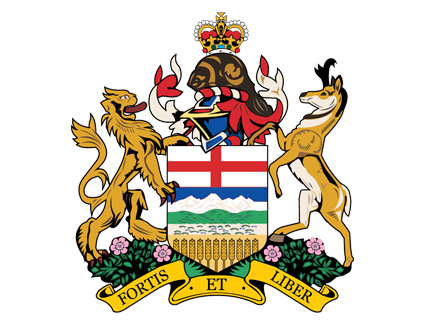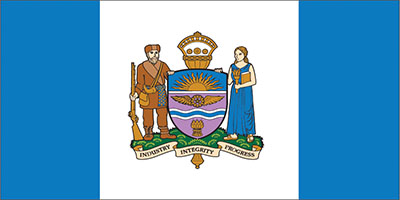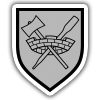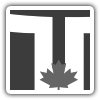Alberta, Canada
Flag
The flag of Alberta was adopted by the Legislature of the Province of Alberta in 1968. The blue field of the flag is charged with the Alberta shield of arms. The shield displays the cross of St. George and features a typical Alberta landscape.

Other Provincial Symbols
- Floral Emblem: Wild Rose
- Tartans: Alberta Tartan/Alberta Dress
- Tree: Lodgepole Pine
- Bird: Great Horned Owl
- Animal: Rocky Mountain Bighorn Sheep
- Fish: Bull Trout
- Stone: Petrified Wood
- Grass: Rough Fescue
- Colours: Blue and Gold
Coat of Arms
Alberta's coat of arms was granted by King Edward VII in 1907. Queen Elizabeth II granted a crest, supporters and motto in 1980 to mark the 75th anniversary of the creation of the province.

The upper portion of the shield displays the St. George's Cross, while the lower part portrays the varied nature of the province's landscape - mountains, foothills, prairie, and grain fields. Above the shield is the crest of a beaver bearing the Royal Crown on its back. Below the shield are wild roses, the province's floral emblem, and the supporters are a lion, a royal symbol, and a pronghorned antelope, an animal indigenous to the province.

Origin of the Name
Alberta was named for Queen Victoria's fourth daughter, Princess Louise Caroline Alberta, the wife of the Marquess of Lorne, who was Governor General of Canada in 1882 when the District of Alberta was created as part of the Northwest Territories. In 1905, the name was retained when the District of Alberta was joined with parts of the Districts of Athapaska, Assiniboia and Saskatchewan to create the present-day province of Alberta.

History
The oldest identified archaeological sites in Alberta date back approximately 11,000 years. When Europeans reached what is now Alberta in the mid-18th century, the area was home to many different First Nations. Historically, the Blackfoot or Siksika, the Peigan, the Blood or Kainai, the Tsuu T'ina or Sarsi, the Kutenai, the Cree, the Assiniboin or Nakota, the Gros Ventres or Atsina, the Beaver or Tsatinne, the Chipewyan and Slavey or Dene Tha', all had close associations with lands now located within Alberta.
In 1778, fur trader Peter Pond established the first fur trade post within the boundaries of modern Alberta. Soon other posts were constructed on the Athapaska, Peace and North Saskatchewan rivers by both the North West and Hudson's Bay companies. Often, the posts were built virtually side-by-side, as at Fort George and Buckingham House on the North Saskatchewan River or Fort Chipewyan and Nottingham House on Lake Athabasca.
Competition for furs ended briefly after the North West and Hudson's Bay companies merged in 1821, but, by the mid-19th century, free traders operating in Alberta reintroduced competition into the fur trade.
In the mid-19th century, several scientific expeditions, most notably Captain John Palliser's expedition of 1857–1860, examined the agricultural potential of the Canadian West. Palliser believed that the Southern Prairies, sometimes referred to as Palliser's Triangle, were too dry for farming, but further north he and other observers, including the notable naturalist and geologist Henry Youle Hind, thought that the land was fertile and well suited to agricultural settlement. In 1869, the British and Canadian governments began negotiations with the Hudson's Bay Company over the transfer of the company's trade monopoly and lands. In 1870, these lands, including most of present-day Alberta, were acquired by the Government of Canada.
Settlement was slow until the Canadian Pacific Railway reached Alberta in 1883. The railway made it easier for new settlers to get to Alberta and to sell the crops they grew. In 1891, a railway was completed from Calgary to Strathcona, across the North Saskatchewan River from Edmonton. Other railway lines followed, including the transcontinental Grand Trunk Pacific and Canadian Northern railways, which reached Edmonton in 1911.
In 1905, Alberta and its neighbour Saskatchewan entered Confederation. For the first time, Canadian provinces were joined from sea to sea. Settlement boomed in Alberta. Land in the new province was readily available at low cost under the Homestead Act or could be purchased from railway and other land companies. The discovery of new strains of wheat and other grains suited to Western Canadian growing conditions and new methods of farming also helped encourage rapid settlement.
In 1891, the population of Alberta was about 26,500 people. By 1901, this number had grown to about 73,000. In 10 years, the population increased over five times to 374,000 in 1911, before increasing substantially again to more than 584,000 in 1921. As a result, the population of Alberta came to be made up of many peoples of different backgrounds, languages and cultures.

Civic Flags
Edmonton, Alberta


Calgary, Alberta


Franco-Albertan Flag

















































